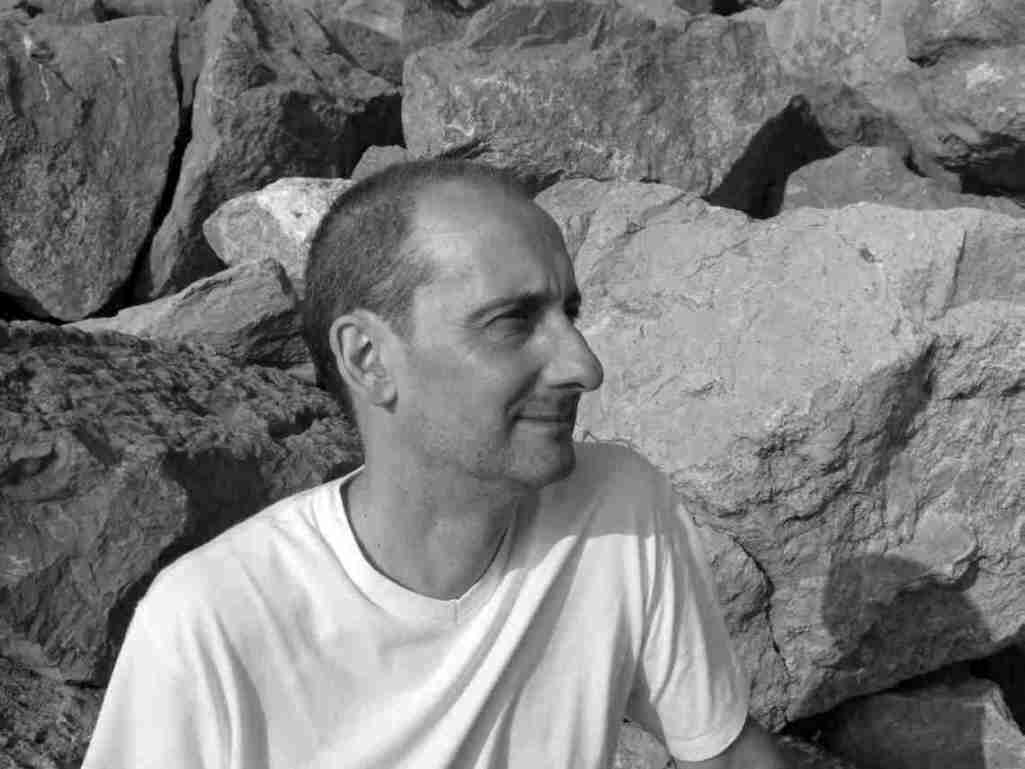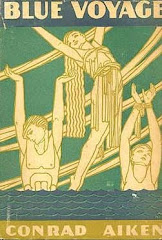
Please play the Bix Beiderbecke track below entitled Dolly Dimples while you read this post:
Lowry met Dolly Lewis on his first trip to the USA in 1929.
Lowry first visited the USA after writing to the American poet Conrad Aiken who he had just discovered after reading Aiken's Blue Voyage, a book which had a profound effect on Lowry. Lowry had suggested to the recently unemployed Aiken that Aiken should become his mentor to help with entry to Cambridge University. Aiken couldn't turn the offer down once Lowry was able to secure funding from his father. When Lowry discovered that Aiken had recently returned to the USA, he "invited" himself over to meet his literary hero who would become his life-long friend. Initially, Lowry stayed with Conrad Aiken in Cambridge Massachusetts at Aiken's apartment in 8 Plymton Street.

The above apartment was just by the famous Grolier Poetry Book Shop opened in 1927.

After a couple of weeks in Cambridge, Aiken took Lowry with him to stay in South Yarmouth, Cape Cod where Dolly lived. Dolly was the step-daughter of Charles D. Voorhis, an old friend of Aiken's.

Lowry's first biographer Douglas Day paints an idyllic picture of Lowry and Dolly going for long walks on the beach, reading poetry and painting as well as visiting the theatre in Boston with Lowry staying over at Dolly's house. This picture is based on the archives of Conrad Knickerbocker who was an early researcher of Lowry's life. Knickerbocker's archive contained letters from Dolly to Knickerbocker in the early 60's.
Day claims that this was Lowry's first proper love affair. This claim was before documentary evidence emerged in the form of two letters from Tess Evans that she and Lowry had been close before Lowry embarked on his sea voyage to the Far East in 1927. When Day wrote his biography, he thought that the character Janet in Ultramarine was a Lowryean fantasy but in actuality the character Janet was based on Tess.

However, according to Lowry's later biographer Gordon Bowker, Dolly says in interviews that she was not smitten with Lowry and found him a nuisance. Either way, both biographers detail that Lowry wrote to her from on-board the SS Cedric on the way home to England.
How much Lowry was in love with Dolly is debatable with Lowry adopting an absurd tone of affection in the letter which couldn't possibly be serious. You can read the full acount in Bowker's Pursued By Furies Pgs. 89-90. The only letter to have been published between Lowry and Dolly is the fragment contained in The Collected Letters Of Malcolm Lowry Volume 1. Day and Bowker elude to a much longer letter written on board the Cedric and perhaps other correspondence.

Lowry did meet Dolly again in 1934, when he visited the Cape Cod area with his first wife Jan Gabrial. Bowker tells the amusing story of Lowry calling Dolly from Provincetown, where he was staying on the trip, inviting Dolly over to meet him and Jan. When Dolly arrived, Jan was absent and she found Lowry drunk on the floor with sheet music for the song "My Dolly" open on the piano. I can only assume that song was the Vincent Youmans classic which I was unable to find but I thought the YouTube video below might suffice to go with whatever was going around Lowry's head! Tea For Two, from the 1925 musical, No No Nanette. Song by Irving Caesar and Vincent Youmans; performed by Helen Clark and Lewis James.
I was intrigued about Dolly and wondered whether she continued with her painting. This is what I discovered:
Artist and environmentalist, Doris ("Dolly") L. Lewis (Henriquez) divided her life among Massachusetts, the Caribbean, and South Florida. Her paternal grandparents descended from old New England families and built a house on Boston's Marlborough Street when the Back Bay neighborhood first opened. Later, some of the family moved to Cambridge, where several in-laws had lived for many years; one had married Longfellow's artist son, Ernest.

On her mother's side, Lewis descended from the prominent "Anglo" Lindo family of Jamaica and Costa Rica. Her grandfather was one of the eight partners of Lindo Brothers, members of which owned extensive plantations for coffee, bananas, and sugar in Jamaica and Costa Rica, as well as the J. Wray rum company, the Daniel Finzi wine and spirit business, and properties on Jamaica's north coast that later were developed into resorts. They also founded the Bank of Costa Rica.
Born in 1909 at the Cecil Lindo (her great uncle) Historic House on Parque Morazan in San Jose, Costa Rica, Lewis returned to a family plantation "El Sitio" at Juan Vinas, with her father, Sidney Lewis (of Cambridge, Massachusetts) and her mother, Daisy ("Mimi") Lindo Lewis (later Voorhis). For a few years just before and during World War I, Sidney Lewis ran mining interests out of Wheeling, West Virginia, but decided to return to Costa Rica in 1919 when his daughter was ten. The family stopped in New York on the way, staying with Doris Lewis's grandfather, August Lindo, on Park Avenue. Before embarking, her father traveled alone to Cambridge to visit his mother for a few days and suddenly died, perhaps a victim of the flu epidemic. After her father's death, Lewis was taken by her mother to live with members of the Lindo family in Jamaica for one year, possibly at her great uncle Robert's plantation, "Sunnyside," two miles outside of Linstead.

Then Lewis and her mother migrated to Cambridge to live near her father's family. In the Boston area she attended the Buckingham School, the May School, and the Museum School. Summering on Cape Cod from the late 1920’s and moving to South Yarmouth about 1934, Lewis at a young age became associated with a group of New York, Boston, and Cape Cod artists and writers, including Van Gogh's acquaintance Dodge McKnight (friend of Isabella Steward Gardner), poet Conrad Aiken, and novelist Malcolm Lowry. Lowry wrote perhaps his most famous letter to her—a 30-page love letter, which remains in her family.
Other artists who were close associates were Howard Gibbs (whose first-class "Still Life" Lewis owned), Harold Dunbar (who painted her portrait, and she, one of him), Byron Thomas (whose famous "The Skater" she owned), Frederick Wight (later associated with UCLA), and Alice Stallknecht (who did two portraits of her). For over sixty years Lewis was a close friend of Catherine Huntington, who owned the Provincetown Playhouse and kept Eugene O'Neill's plays alive during the 1940's. She also painted Huntington's portrait.
On Cape Cod Doris Lewis at first painted typical Cape landscapes in oil, which exhibited in Cambridge in the early 30's. But at the same time she produced a strong body of modernist surrealistic oils, which exhibited at the Provincetown Art Association, Boston's Museum of Fine Arts, and other locations. She also painted in New York and Boston.

Through her mother's family, Lewis maintained keen interest in the Caribbean, and in 1937 married Anglo-Jamaican Edward Henriquez in Havana, where she spent the next twelve years. Henriquez had been educated at Belmont Hill School, founded partially for him and his brother by the Atkins family, who had extensive sugar holdings in Cuba and land in Belmont outside Boston. An "Anglo" herself, Lewis—unlike many North Americans—showed great interest in and love for both native peoples, Cuban Hispanics and Blacks.
Briefly in the late 1930's—when her husband's sailboat was being built—Lewis lived under primitive conditions among Afro-Cuban sugarcane workers some distance from the cultivation of Havana. During the day the men toiled in the fields, and Lewis was struck by the spiritual faces of the women and children left at home—especially by their long-suffering and innocence. The only art materials she had with her were conte pencils and a sketchpad. And so were born 25 character-full portraits in an exhibit, "Faces of Afro Cuba," which showed posthumously at the African Meeting House on Beacon Hill in 1996.

In 1949 Lewis returned to the States to live in Florida for the rest of her life. There, in addition to pursuing her own artwork in hard-edge oils and in pottery, she personally encouraged countless artists, potters, and gardeners, as well as serving on various county- and state-wide boards and founding the Ceramic League of Palm Beach County. She also performed a busy, vocal, and courageous role in Florida's environmental affairs and is credited as one of the leading activists to save the Everglades. She died in 1995 at her home in West Palm Beach.JAMES R. BAKKER ANTIQUES, INC
As ever with Lowry there is an ironic touch in the above which I enjoyed. The fact Dolly came from a family who owned rum distillers would have surely made her interesting to Lowry even if they had to drink bootleg booze due to prohibition. Dolly also painted the picture below called Circus which includes a ferris wheel which was such a potent symbol in Lowry's Under The Volcano. Dolly painted Circus in 1939 just as Lowry was struggling with the first drafts of Under The Volcano.

One of the reasons why I was intrigued by Dolly was after reading Lowry's letter to Conrad Aiken on 24 April 1931 which included the following about Dolly:
Thank God Dolly's got a job. I was thinking last night of her saying - I'm so excited you GNAW, I must always get a little bit aTIPSY you GNAW MRS CHERRY MRS CHERRY oh I'm so excited you GNAW. Jesus bloody christ I was nearly sick when I thought of her - I wonder why she knocked at my door the last night all the same-
We will never know the true extent of their relationship but perhaps Lowry invited her over to his temporary Provincetown home to find out why she knocked on the door and then got too drunk.







Glad to see this website. Dolly was my mother-in-law, and we have many paintings by her, in which there seems to be increasing interest, esp. the surrealist ones. Her artwork evolved from landscapes to surrealism to hard-edge through the years. We also have materials by Malcolm and Conrad, who came to our wedding. This includes Malcolm's famous 32-page love letter to Dolly, penned on a ship of the White Star line. It's not exactly true that she met Malcolm again in 1934 since, as you say, he had passed out. She closed the door, and as far as my wife and I know, she had nothing else to do with him. Conrad's wife, Mary Hoover, did a portrait of Dolly's step-sister.
ReplyDeleteThanks for dropping by and for your interesting comments
ReplyDeletePlease drop me a line at my email address:
colin.dilnot@gmail.com
Oh, I forgot to mention that Dolly lived in Cambridge, not Boston. If Lowry in fact stayed over at her (mother's) house, it probably would have been there, but I should think that he stayed with Aiken. Also, the biographers and Aiken may have made too much of this relationship.
ReplyDelete